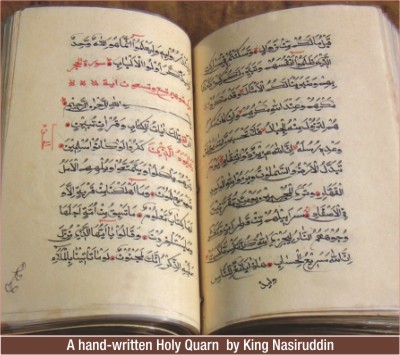| Journy through Bangldesh
From Natore
Chalanbeel Museum
Hasibur Rahman Bilu

On first reaching the “Chalanbeel Museum” area in Khubjipur village, one might be a little disappointed not finding anything like a museum. Discovering the fact that the small bougainvillea- covered room is what constitutes the entire museum might even be a bit annoying considering the long tiring journey to the village! However, hearing of all the treasures preserved in that tiny room, such as, the age-old scriptures engraved on tree barks, or of meeting a person who has given up everything important to him to keep this museum alive, is bound to arouse some enthusiasm to go inside. The very chance to touch a version of the Holy Quran delicately written out by none other than the Emperor Alamgir and Badshah Nasir Uddin is perhaps enough to dissolve the exhaustion of a tiresome journey taken to reach there.

One of the four handwritten constitutions of Bangladesh is also preserved here at the Chalanbeel Museum. A visit to the museum gives one the opportunity to see many different types of currencies from all over the world, parts of a slab that was used to build an Egyptian pyramid, many different kinds of statues, a manuscript written in the national tongue from the Mughal Era along with many other interesting artifacts such as, a three headed piece of bamboo which has been carefully placed atop an antique wooden wardrobe. The age old currencies including notes worth ten thousand from Subhash Chandra Bose's Azad Hindu Fauj is bound to take you right back in history. Also preserved in the museum are the pieces of pottery which were found during the excavations in different areas of the Chalanbeel. Youngsters standing before a piece of exhibition in the room might ask you what a “baera khorom” is because it is a thing of an older time and age and can be found only in museums.
The Chalanbeel was founded by the sole initiative of Professor Abdul Hamid. It is situated in Khubjipur village of Gurudashpur in Natore and was first started in 1978. Sadly, there is absolutely no record of the people who have visited the museum since 1978 as there are no ticket counters of any sort.
 Professor Hamid, a man of extensive knowledge and experience, can even at the age of 74, clearly recall several events of the past. He had rejected the “Togmai Khedmadgar” award for social work by the Pakistan Government many years ago. Although he had rejected the award, he has never been able to disregard the love of the expectant people of his village. So this highly educated gentleman decided to retire from government service and spend the final years of his life serving the people of Khubjipur village. The people of the area hold him in the highest esteem because of his love, concern for the people and contribution to the society. Many people come to the village just to meet this extraordinary individual with the same enthusiasm that brings them to visit the museum. Professor Hamid, a man of extensive knowledge and experience, can even at the age of 74, clearly recall several events of the past. He had rejected the “Togmai Khedmadgar” award for social work by the Pakistan Government many years ago. Although he had rejected the award, he has never been able to disregard the love of the expectant people of his village. So this highly educated gentleman decided to retire from government service and spend the final years of his life serving the people of Khubjipur village. The people of the area hold him in the highest esteem because of his love, concern for the people and contribution to the society. Many people come to the village just to meet this extraordinary individual with the same enthusiasm that brings them to visit the museum.
Even though the museum was officially said to be a preserved site, the concerned authorities are yet to take action for its development. Nothing has been done for proper preservation of the artifacts and not enough people are appointed for the maintenance of the museum.
To visit the museum from Dhaka, one can take the bus and go up to Jamuna Bahumukhi Bridge. After crossing the bridge, the Hatikumorul Banpara road leads one to the Jol Plaza, after crossing which one has to take the Gurudashpur road to go up to the market place.
Cars and buses can only reach up to this point, so one has to cross the river and once it has been crossed, one can take a rikshaw van to take him to Khubjipur. The village is well known because of the museum and anybody can provide a visitor the directions to the Chalanbeel Museum. While planning a visit there, one must remember that the museum remains closed on Saturdays.
Since there is no good place to stay near the museum, one needs to go to Bogra, Sirajganj, Pabna or Natore zilla sadar if one plans to stay over.
Translated by
Izmet Nashra Khan
Copyright
(R) thedailystar.net 2006 |
